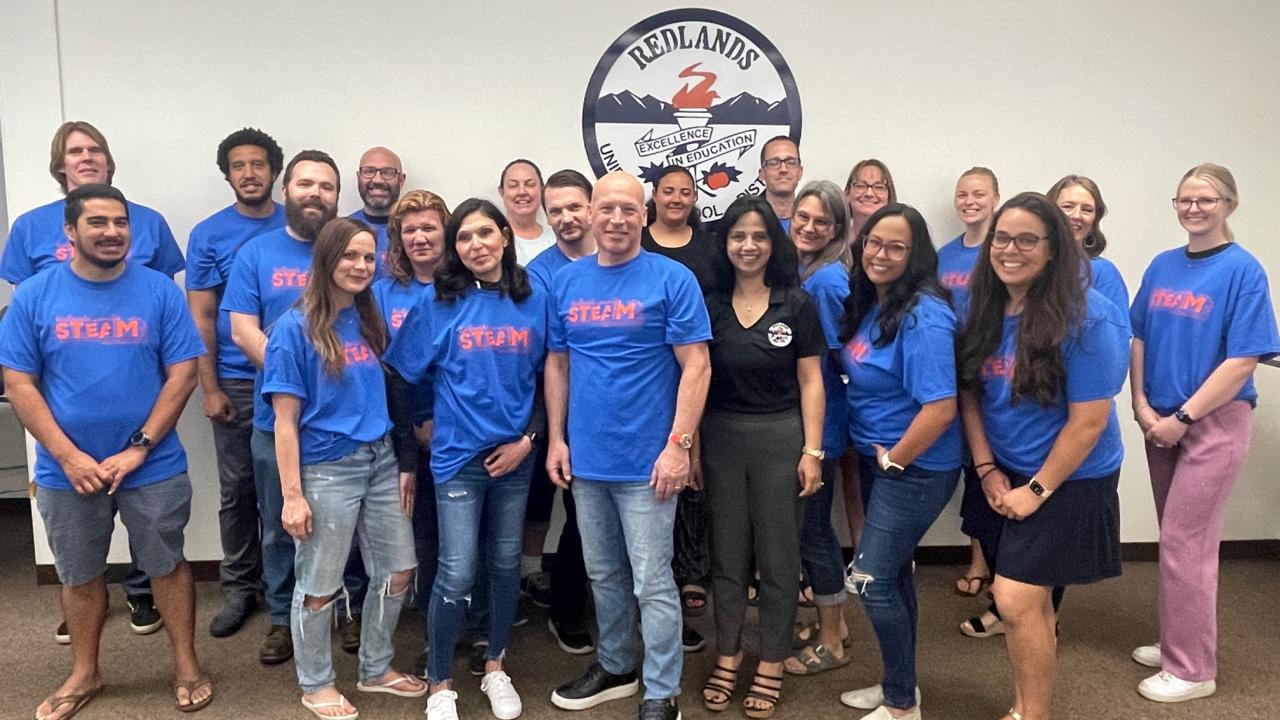Twenty-five teachers from Redlands Unified School District in southern California recently completed training in integrating computer science into math education through a joint program offered by the University of California, Davis, and UC Riverside Extension. The Joint Computer Science Supplementary Teaching Credential Authorization Program has helped Redlands address gaps in student opportunity and achievement, and teachers’ skills.
“Improving math instruction for student success is the most challenging task in education. Redlands partnered with UC Davis to make math instruction with computer science a reality for many of our students who have historically disconnected from learning math,” said Ken Wagner, assistant superintendent of Redlands Unified School District. “More students are demonstrating resilience and persistence in their math progression than ever before, which to us, is an immeasurable outcome.”
Redlands is the first school district in the nation that has 25 teachers who have gone through four college-level courses needed to earn their credential. This innovative practice is transforming public K-12 math and computer science education.
“C-STEM training and use of the robotics and programming skills that are taught has been the best professional development training of my 28-year career,” said teacher Roland Hosch. “I am very grateful to be a part of it and my classroom is a more efficient and more effective place to learn because of it.”
Transforming math education
The UC Davis Center for Integrated Computing and STEM Education, or C-STEM, program aims to transform K-12 math, computer science and STEAM (science, technology, engineering, arts and mathematics) education through integrated learning. Students learn to solve math and algebra problems through coding and by programming small, modular robots. The C-STEM Math-ICT curriculum provides up to 13 years of integrated math and computer science teaching from kindergarten through high school. C-STEM courses have UC A-G status, satisfying admissions requirements for the University of California and California State Universities.
Redlands USD implemented the C-STEM program in 2018 to narrow the achievement gap in math and address the opportunity gap in computing. The district has expanded from two middle school teachers initially to 35 teachers, including all the district’s middle and high schools as well as six elementary schools, in 2022-23.
Redlands has seen results with the program. From the 2018-19 school year to 2021-22, average scores on the mathematics diagnostic testing project (MDTP) rose by more than 13% in C-STEM classes compared to peers in traditional math classes in the same schools. (Redlands students can choose either a C-STEM math track, plus a computer science class, or a traditional math class.)
“C-STEM brings joy into the classroom,” said Deepika Srivastava, STEAM coordinator for the Redlands school district. If you give a student a worksheet of math problems and they get 20 or 30% right, it tells the student “You’re bad at this,” she said.
“But if they are trying to solve a problem by writing a program, they can get it 20 or 30% right, get some feedback, and improve. When you’re solving a math problem by coding, it’s an iterative process, there’s constant feedback,” she said. “It encourages students to keep trying and develops skills in critical thinking, problem solving and perseverance.”
Further, she said that the C-STEM math classes have become more diverse, with more representation of girls, Black and Latinx students, and students from lower socioeconomic backgrounds. Perhaps most significantly, surveys of students entering and completing the program show a big swing from “I hate math” to “I enjoy math.”
Addressing the opportunity gap
“Redlands is a good example of a school district working with C-STEM to address the ‘opportunity gap’ in math education,” said Harry Cheng, director of the C-STEM center and professor in the UC Davis Department of Mechanical and Aerospace Engineering. “Schools are working to get students back on track after the pandemic. The students are doing better, closing the achievement gap and teachers are learning new skills, closing the skills gap.”
Srivastava, who visits all the district classrooms using the C-STEM program, said that the program also has positive effects on student behavior.
“When a kid fails at math, they get the message that they’re not good at math and then they don’t give 100%. But when they’re building a robot, their entire attitude changes. I truly believe this is where the future is.”
The UC Davis Center for Integrated Computing and STEM Education is a comprehensive program that includes the annual RoboPlay competition in which students compete with other schools to solve challenges with coding and robotics. In addition to K-12 curricula and professional development for teachers, the center also supports schools and districts to organize their afterschool and summer programs, including robotics camps, robotics-math camps, the Girls In Robotics Leadership (GIRL/GIRL+) camps, and Ujima GIRL Project for African American middle and high school girls.
“Ever since the pandemic, we have been challenged to find new ways to engage our students,” said teacher Noah Rosen. “The investment that Redlands Unified has made in my continued training in C-STEM has provided me with a whole new treasure chest of tools that I can use to elevate the effectiveness of my classroom instruction through computer science.”
Media Resources
Joint UC Davis/UCR Computer Science Supplementary Teaching Credential Authorization Program
Media Contacts:
- Harry Cheng, C-STEM Center, hhcheng@ucdavis.edu
- Merry Kim, C-STEM Center, mekim@ucdavis.edu
- Andy Fell, UC Davis News and Media Relations, 530-304-8888, ahfell@ucdavis.edu
